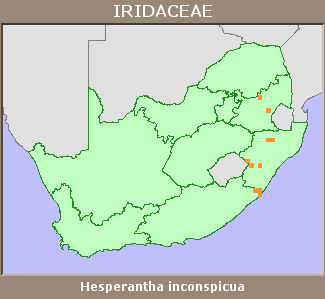|
Scientific Name | Hesperantha inconspicua (Baker) Goldblatt |
Higher Classification | Monocotyledons |
Family | IRIDACEAE |
Synonyms | Gladiolus inconspicuus Baker |
National Status |
Status and Criteria | Least Concern |
Assessment Date | 2021/06/02 |
Assessor(s) | W. Foden, L. Potter & T. Patel |
Justification | This species has an extent of occurrence (EOO) of 56 977 km², and an area of occupancy (AOO) of 52 km². It is known from ten subpopulations. It is listed as Least Concern. |
Distribution |
Endemism | South African endemic |
Provincial distribution | Eastern Cape, KwaZulu-Natal, Mpumalanga |
Range | This species is endemic to South Africa, and is found from the Blyde River hills and Lydenburg in Mpumalanga to the Mtamvuna River Gorge in southern KwaZulu-Natal. |
Habitat and Ecology |
Major system | Terrestrial |
Major habitats | Forest, Grassland, Savanna |
Description | It occurs between and under rocks, in moist soil. |
Threats |
| Habitat loss and degradation due to agriculture and infrastructural developments are threats which have been noted in three of the subpopulations. |
Population |
It has mostly been recorded as locally common and frequent, however, records give no indication of actual population numbers. It is known from 10 subpopulations and the population is stable.
|
Population trend | Stable |
Assessment History |
Taxon assessed |
Status and Criteria |
Citation/Red List version | | Hesperantha inconspicua (Baker) Goldblatt | Least Concern | Raimondo et al. (2009) | |
Bibliography |
Goldblatt, P. and Manning, J.C. 2020. Iridaceae of southern Africa. Strelitzia 42. South African National Biodiversity Institute, Pretoria.
Raimondo, D., von Staden, L., Foden, W., Victor, J.E., Helme, N.A., Turner, R.C., Kamundi, D.A. and Manyama, P.A. 2009. Red List of South African Plants. Strelitzia 25. South African National Biodiversity Institute, Pretoria.
|
Citation |
| Foden, W., Potter, L. & Patel, T. 2021. Hesperantha inconspicua (Baker) Goldblatt. National Assessment: Red List of South African Plants version 2024.1. Accessed on 2025/10/26 |
 Comment on this assessment
Comment on this assessment


